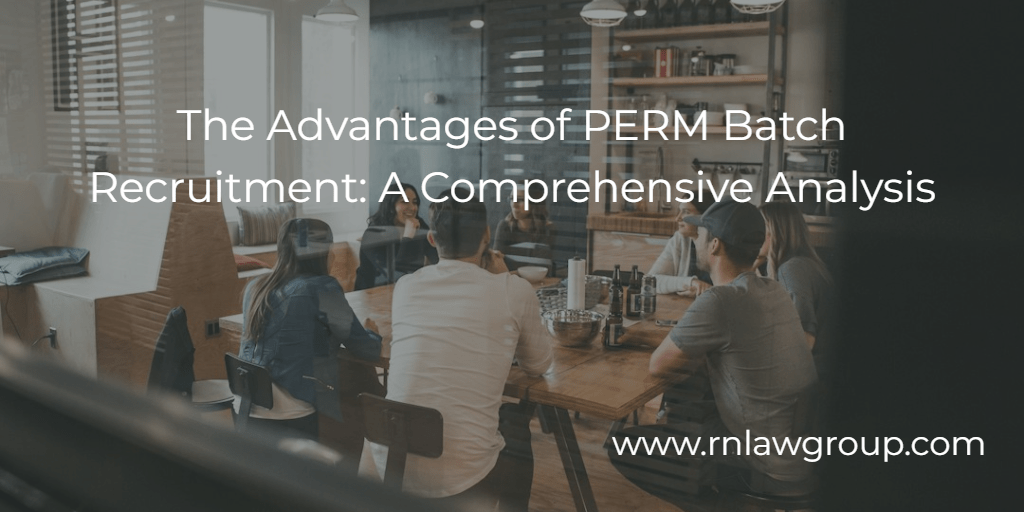
The Advantages of PERM Batch Recruitment: A Comprehensive Analysis
The PERM labor certification process is usually the first of three steps in the employment-based green card process. The PERM process is lengthy, involves multiple stages, including conducting a series of recruitment activities, and requires careful strategizing for a successful outcome. The intricacies of the PERM process can be difficult for businesses to navigate. In particular, businesses that have a high-volume of immigration cases can experience unique challenges when it comes to filing PERM labor certifications for their employees. The process can become overwhelming, time consuming, and very costly.
Due to these unique challenges, some employers choose to implement “batch” PERMs under the right circumstances. Batch recruitment for PERMs typically occurs when employers have streamlined job titles and job descriptions for their available positions. Further, employers utilizing batch recruitment will typically have reasonably generic job descriptions and minimum requirements for their ongoing job opportunities. In this situation, batch recruitment allows employers to more efficiently handle multiple job openings for the same position within a single recruitment process, presenting a strategic and organized approach to PERM labor certification. This is especially beneficial for employers who have a higher volume of nonimmigrant employees. Employers seeking to utilize this strategy should carefully consider both the associated advantages and challenges involved in order to ensure a successful outcome.
Advantages:
- Time and Cost Savings: Batch processing allows employers to process multiple cases at once, which can save time and streamline the overall process. This option allows employers to use the same prevailing wage determination and same recruitment for their ongoing job opportunities with multiple openings. This can cut down on the cost of advertisements because employers can advertise as “multiple openings” instead of utilizing an advertisement for each individual PERM. The cost savings can be significant, especially in regard to the newspaper of general circulation, which can run thousands of dollars. For example, Company A is planning to file a PERM application for 10 Software Engineers. The cost of the newspaper of general circulation is $1,500 for the advertisement content. If the timing/circumstance, duties, and minimum requirements allow for batch recruitment, the employer could use the same advertisement for all 10 PERM applications, significantly reducing the cost from $15,000 to $1,500.
- Consistency: When filing batch cases, employers can more easily ensure consistency in the preparation and submission of documentation, reducing the likelihood of errors or omissions. Further, employers sometimes struggle with the concept of minimum requirements for the job opportunity and batch recruitment can help ascertain those requirements and keep them consistent across similar jobs. This in turn can offer consistency in the employer’s hiring process, leading to faster review and analysis of each sponsored employee’s qualifications for the job opportunity.
- Resource Optimization: Employers can optimize resources by managing and coordinating the preparation of multiple cases concurrently, making the process more efficient. For example, there could be a streamlined strategy of gathering all employee internal questionnaires and documentation at once so that a quick and thorough review can be conducted to ensure each employee meets the minimum requirements for the position. This however should be coordinated with a qualified employment-based immigration attorney to ensure full compliance with DOL and USCIS rules. For example, a thorough review of each employee’s documentation is crucial to ensure not only that the employee qualifies for the position, but that each employee also qualifies for the relevant Employment Based category (e.g., EB-2/EB-3) so that the I-140 is not denied later down the line.
- Minimize Errors, Maximize Success: While it’s important to recognize that guarantees cannot be made in the immigration process, preparing and submitting multiple cases simultaneously under the same PERM recruitment can provide employers with a higher chance of approval. By adopting a coordinated approach, employers can methodically address common issues and concerns across all cases within the batch, resulting in a decreased margin of error. This ensures a more uniform review process, minimizing the risk of overlooking essential details and enhances the likelihood of quality submissions. This, in turn, strengthens the chances of surviving the Department of Labor’s (DOL) strict scrutiny and obtaining approval for PERM labor certifications, making it a practical and beneficial approach for employers seeking a streamlined and efficient pathway to securing qualified workers for their organizations.
- Strategic Planning in Recruitment: Employers can strategically plan and manage recruitment efforts, ensuring that they are meeting regulatory requirements and maximizing the chance of successful certification in the event of an audit. Posting advertisements for the same position with multiple openings allows for a single review of all recruitment efforts minimizing the chance for errors in job postings. Further, the review of applications/resumes is more streamlined in that employers are considering all applicants for a single job posting rather than for multiple individualized advertisements. This process can help consolidate the employer’s recruitment report, leading to a faster and more accurate internal process. Again, this is only possible where the employer has genuine ongoing job opportunities with multiple openings.
Challenges:
- Higher Workload at Once: Handling batch recruitment often means dealing with a higher workload at once. This can be challenging for smaller HR or legal departments, potentially leading to increased stress and pressure. At the outset of the process, employers and their attorneys will usually have to gather and review all employee documentation at once, which can be very time consuming. Additionally, PERM is an exacting process and involves very specific timing requirements. If the employer runs batch recruitment for multiple cases, each case will have the same filing deadline. It can be difficult to meet these deadlines if all parties involved are not adequately prepared to handle the high workload. Working with a qualified immigration firm that has the internal infrastructure and an experienced team can significantly reduce any potential difficulty on the employer.
- Limited Flexibility: Batch processing may limit the ability to adapt quickly to changes or address unique circumstances for individual cases. Each case might need a more specific approach, and batch processing may not allow for this level of customization. Batch processing typically works best for more generic job descriptions.
- Complexity of Coordination: Coordinating the preparation and timely submission of multiple cases simultaneously can be complex. Ensuring that all required documents are gathered, reviewed, and submitted correctly requires careful planning and organization. In order for this strategy to work efficiently, there must be a coordinated effort between the employer and their legal representation. If neither party is knowledgeable on how to process batch recruitment, employers risk noncompliance and potential denials of their PERM applications. This can be mitigated by working with a qualified immigration attorney to help guide the company through this process. For example, having internal questionnaires for each applicant and an organized review process can significantly improve an employer’s experience and outcome. Without the proper means, employers and their legal representation can quickly become overwhelmed by the high-volume of information and documentation involved in batch recruitment.
- Potential Ability to Pay Issues: An employer sponsoring a foreign worker for a PERM based green card must demonstrate its Ability to Pay (ATP) the beneficiary the prevailing wage listed on the labor certification from the time the PERM application is filed to the time the green card is issued. For high-volume PERM filers, USCIS may request, during the second stage (I-140) of the green card process, proof of the employer’s ability to pay all beneficiaries, rather than just one. Filing all PERM applications close together under the batch system could create an issue where the employer’s ability to pay is called into question. That being said, there are multiple ways to demonstrate ability to pay. A qualified immigration attorney can review all avenues to ensure the employer can meet this requirement, even in a high-volume filing situation.
The adoption of batch recruitment in PERM labor certification cases presents a beneficial strategy for employers under the right circumstances. The advantages of time and cost savings, consistency in documentation, resource optimization, minimizing chance of error, and strategic planning collectively outweigh the challenges. While careful consideration of challenges is essential, the overall efficiency and potential benefits can make batch recruitment a valuable approach for high-volume filers in the complex landscape of PERM labor certification. With the right legal guidance by a qualified immigration attorney, employers can navigate these complexities successfully and achieve the desired outcomes in a simplified and effective manner.
At Reddy Neumann Brown PC. we are committed to simplifying the PERM application process for employers by strategizing proactive measures that will enable businesses to file PERM applications in a more efficient and cost-effective manner for their employees. Our dedicated PERM team brings over 20 years of combined PERM experience to ensure businesses remain compliant while developing the best plan of action to meet business needs. Additionally, at Reddy Neumann Brown PC, we offer cutting-edge technology through our proprietary LIBERTY portal, which is available to all our clients. Our portal allows for the completion of employee questionnaires and submission of documentation for easy review and access by our dedicated team.
Further, as an immigration law firm that has been serving our clients for over 25 years, our team is here to offer prompt, practical, and professional advice, whether you’re a company seeking to hire top talent to grow your business or a foreign worker wanting to develop a career in the United States. If you have any questions, please schedule a consultation with one of our attorneys at https://appointments.rnlawgroup.com/.
By: Krystal Alanis
Krystal Alanis is a Partner at Reddy Neumann Brown PC with over 10 years of experience practicing U.S. business immigration law. Krystal manages the firm’s PERM Labor Certification Department, where she oversees all EB-2 and EB-3 employment-based green card matters. Krystal guides clients from a variety of industries through the maze of the PERM Labor certification process and has handled thousands of PERM applications throughout her career. Krystal guides employers through the I-140 and Adjustment of Status process, and assists clients with temporary work visas. Further, she oversees the firm’s I-9 compliance team where she advises employers regarding Form I-9 Employment Eligibility Verification requirements and conducts internal audits of a company’s I-9 records, processes, and procedures. Additionally, Krystal represents clients in Form I-9 U.S. Immigration and Customs Enforcement (ICE) inspections (Notice of Inspection). Krystal successfully settled a claim with ICE over Form I-9 substantive paperwork violations that led to an 88% reduction in civil fines for her client.

